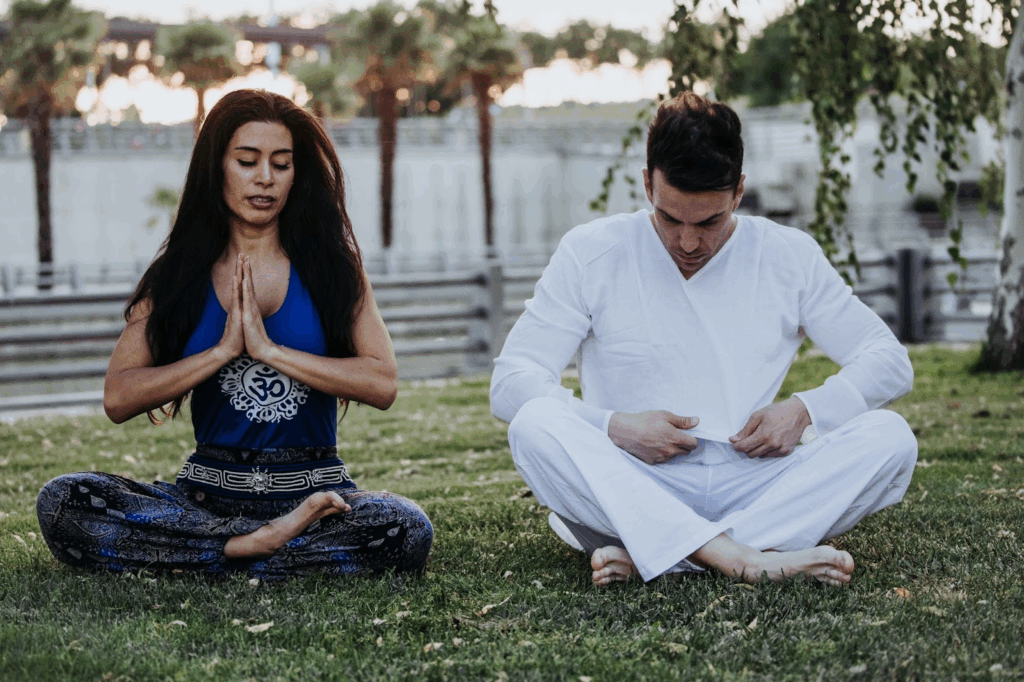Meditation is not a single technique but a family of practices that train attention, awareness, and attitude. Different approaches nudge the nervous system in various ways—some sharpen focus, some soften reactivity, and others expand compassion. When practiced consistently, these shifts can lead to calmer days, clearer thinking, more resilient moods, and even measurable improvements in sleep quality and pain perception. The key is finding a style that suits your life, allowing the benefits to compound over time.
A Bridge Between Mind and Body With Different Forms of Meditation
Meditation works because the mind and body are not separate departments. When attention steadies, breathing deepens, heart rate variability can improve, and muscles unclench; when the body settles, the mind has more room to organize thoughts and set priorities. Over time, this feedback loop reduces the background static that drains energy. You’re not escaping life—you’re upgrading the way your brain and body process it, so decisions, relationships, and recovery feel less uphill.
Target Stress Physiology With Unique Forms of Meditation
Stress is a natural part of being human, but chronic stress can quietly tax the immune system, disrupt sleep, and impact mood. Techniques that emphasize breath pacing, open monitoring, or guided relaxation can downshift the sympathetic “go” response and strengthen your capacity to return to baseline after spikes of pressure. With repetition, your default becomes less reactive and more responsive.
Nervous System Reset
Slow, even breathing, paired with simple awareness cues, signals to the body that it’s safe enough to relax.
Hormones And Inflammation
Regular practice can support steadier stress chemistry, which may help tame inflammatory cascades.
Forms of Meditation for Focused Attention and Cognitive Clarity
Some styles train a laser-like focus by returning attention to a single anchor—often the breath, a sound, or a phrase. Each gentle return is a rep for your attentional “muscle,” building stamina for deep work and reducing the pull of distractions. People often notice fewer mental tabs open, a tighter feedback loop for catching mind-wandering, and a clearer handoff between tasks. Over weeks, that translates into cleaner execution, fewer errors under pressure, and a more forgiving inner narrator when mistakes happen.
Compassion and Social Connection Fostered by Forms of Meditation
Practices that cultivate warmth—directed toward yourself, loved ones, and even difficult people—reshape the emotional climate in which you live. They help dissolve the brittle edges of self-criticism, making it easier to assume good intent, listen longer, and repair more quickly. The payoff is personal and social: steadier mood, less loneliness, and relationships that can hold honest conversations instead of scripted exchanges.
Why Warmth Matters
Softening self-talk reduces defensive reactions and opens space for wiser choices.
Ripple Effects At Work
Teams feel braver offering ideas when empathy is the norm rather than the exception.

Breath and Body Awareness Forms of Meditation
Body-centered approaches anchor attention in physical sensations—such as breath in the chest, weight through the feet, and tiny shifts in posture. This steadying awareness turns your body into a dashboard that signals when tension is building and where you can release it. The practical result is fewer days hijacked by subtle stress, faster recovery after conflict, and a clearer understanding of your energy so that you can say yes or no with integrity.
Forms of Meditation Useful in Pain and Chronic Conditions
Meditation cannot erase pain, but it can change the way pain is processed. By disentangling raw sensation from the story around it, you can dial down catastrophizing and create space for effective coping. Many people report a wider window of tolerance and a more flexible response to flares, which helps them continue to move, work with providers, and live life beyond the diagnosis.
Pain Reappraisal
Learning to label sensation without judgment reduces secondary suffering that comes from fear and resistance.
Gentle Consistency
Short daily sessions tend to be more effective than occasional marathons when symptoms ebb and flow.
Incorporate Different Forms of Meditation in Everyday Movement
Not all meditation happens on a cushion. Walking, slow-flow yoga, and tai chi fold attention training into motion, which is ideal if stillness feels like a struggle. Coordinating breath with movement builds proprioception, tones stabilizing muscles, and can help reduce the aches that come from long hours at a desk. Because movement-based practice fits into the cracks of a busy day, it often becomes the most sustainable gateway to more extended, quieter sessions when time allows.
Forms of Meditation for Sleep and Emotional Regulation
Evening practices that emphasize paced breathing, body scanning, or simple visualization can ease the transition from “doing” to “resting.” By training the mind to notice thoughts without chasing them, you shorten the runway to sleep and reduce the 2 a.m. spiral. The same skills translate to daytime regulation: fewer impulsive reactions, more productive pauses, and a calmer return after hard conversations.
Wind Down Rituals
Repeating a brief sequence every night conditions the brain to associate those cues with rest.
Interrupting Rumination
Naming a thought as a thought loosens its grip so you can gently return to the present.
Perform Different Forms of Meditation to Ease Pressure
Athletes, artists, and executives utilize meditation to strike a balance between intensity and recovery. Training attention increases access to “flow,” where skill meets challenge and self-consciousness recedes. Equally important, recovery practices prevent the stress response from becoming chronic. Over time, you learn to push hard without compromising your sleep, relationships, or sense of self.
Forms of Meditation For Teens and Families At Home
Family-friendly approaches keep things short, playful, and regular. Two minutes of shared breathing before school, a gratitude reflection at dinner, or a quiet check-in at bedtime install simple rails that guide emotions without lecturing. Teens often prefer movement or music-based anchors; letting them customize increases buy-in. What starts as a small ritual often evolves into a shared language for navigating conflict and celebrating victories.
Shared Moments
Tiny rituals stacked onto existing routines survive busy schedules and shifting moods.
Autonomy With Guardrails
Let kids pick the style while adults model consistency and kindness.
Forms of Meditation in Clinician and Caregiver Burnout
For those who care professionally or at home, emotional energy is the currency of the job. Brief on-the-spot practices between tasks can clear sympathetic “Residue,” so the next patient or family member receives a fresh presence rather than leftover stress. Over time, these micro-resets protect empathy, reduce error risk, and make it easier to leave work at work, so that home can refill the tank.

Motivation Boosting Forms of Meditation
The irony of stress is that it convinces you there’s no time to do the thing that would help. On those days, aim embarrassingly small—one minute, one breath, one phrase—and count anything as a win. By lowering the bar, you keep the habit alive, which matters more than intensity. Motivation tends to follow action, not precede it, and the smallest session often opens the door to a slightly longer one the next day.
Make It Frictionless
Keep your cues obvious—use the same chair, the same time, and a simple anchor—so starting takes no debate.
Track The Feel
Jot a quick note about mood or focus after sessions to notice subtle gains that reinforce the habit.
Forms of Meditation in the Workplace Without Slowing Output
Meditation doesn’t have to compete with productivity; it can lubricate it. One to three minutes between meetings resets attention and reduces emotional carryover. Teams that normalize brief pauses often find meetings shorter, feedback cleaner, and conflict less personal. Leaders who model the practice send a quiet signal that steadiness is part of performance, not an optional extra for off-hours.
The Science of Repetition and Forms of Meditation
The brain changes through repetition and relevance. Daily practice—however short—builds the neural pathways that make calm, focus, and compassion easier to access under real-world pressure. Relevance keeps you showing up, which is why it helps to link your practice to a goal you care about: being a more patient parent, a steadier manager, or a kinder partner to yourself. When practice serves a story that matters, consistency stops feeling like discipline and starts feeling like alignment.
Tie it to Meaning
Clarify the why, so the when and how become easier to protect.
Respect the Curve
Benefits often arrive gradually, then all at once, as skills stack and reinforce one another.
Forms of Meditation for Choosing a Style and Getting Started
If you’re new, sample various methods for a few weeks, then choose one and commit to it for a month so your nervous system can learn it well. Focused-attention practices suit restless minds that like clear instructions. Open-monitoring methods help you notice thoughts and sensations without grabbing them. Compassion training is ideal if self-criticism is loud or you want to soften relational friction. Movement-based styles fit bodies that don’t love stillness. Whichever you choose, keep it simple, keep it short, and attach it to something you already do so it becomes part of the day rather than an appointment you dread rescheduling.
Forms of Meditation for a More Resilient Life
The real benefit isn’t a perfect session but a different way of moving through the day. With practice, you catch yourself sooner when spirals start, you return faster when disruptions hit, and you extend more grace when people struggle—including you. Your body learns how to unclench, your attention learns how to refocus, and your values get a louder vote in how you spend your time. That’s how meditation quietly upgrades mental and physical health: not by adding more to your plate, but by helping every part of you pull in the same direction.
Visit The Living Church blog to learn more about various forms of meditation.



